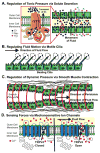Fluid mechanics as a driver of tissue-scale mechanical signaling in organogenesis
- PMID: 28163984
- PMCID: PMC5282515
- DOI: 10.1007/s40139-016-0117-3
Fluid mechanics as a driver of tissue-scale mechanical signaling in organogenesis
Abstract
Purpose of review: Organogenesis is the process during development by which cells self-assemble into complex, multi-scale tissues. Whereas significant focus and research effort has demonstrated the importance of solid mechanics in organogenesis, less attention has been given to the fluid forces that provide mechanical cues over tissue length scales.
Recent findings: Fluid motion and pressure is capable of creating spatial gradients of forces acting on cells, thus eliciting distinct and localized signaling patterns essential for proper organ formation. Understanding the multi-scale nature of the mechanics is critically important to decipher how mechanical signals sculpt developing organs.
Summary: This review outlines various mechanisms by which tissues generate, regulate, and sense fluid forces and highlights the impact of these forces and mechanisms in case studies of normal and pathological development.
Keywords: birth defects; ion channels; mechanics of development; mechanotransduction; morphogenesis.
Conflict of interest statement
Rachel Gilbert, Joshua Morgan, Elizabeth Marcin, and Jason Gleghorn declare that they have no conflict of interest.
Figures

References
-
- Nelson CM, Gleghorn JP. Sculpting Organs: Mechanical Regulation of Tissue Development. Annu Rev Biomed Eng. 2012 Aug 15;14(1):129–54. - PubMed
-
- Gleghorn JP, Manivannan S, Nelson CM. Quantitative approaches to uncover physical mechanisms of tissue morphogenesis. Curr Opin Biotechnol. 2013 Oct;24(5):954–61. This paper reviews the current experimental techniques and models used to quantify physical forces acting on cells and tissues during development. - PMC - PubMed
-
- Davidson LA. Embryo mechanics: balancing force production with elastic resistance during morphogenesis. Curr Top Dev Biol. 2011;95:215–41. - PubMed
-
- Mammoto T, Mammoto A, Ingber DE. Mechanobiology and Developmental Control. Annu Rev Cell Dev Biol. 2013 Oct 6;29(1):27–61. - PubMed
-
- Heisenberg C-P, Bellaïche Y. Forces in Tissue Morphogenesis and Patterning. Cell. 2013 May;153(5):948–62. This paper reviews the various forces that act on the cellular level (cell-EMC and integrin forces, cell-cell interactions, internal actin-myosin forces, etc.), mechanotransduction into cellular signals, and how these forces can influence morphogenesis. - PubMed
Grants and funding
LinkOut - more resources
Full Text Sources
Other Literature Sources
Research Materials
